Figure 1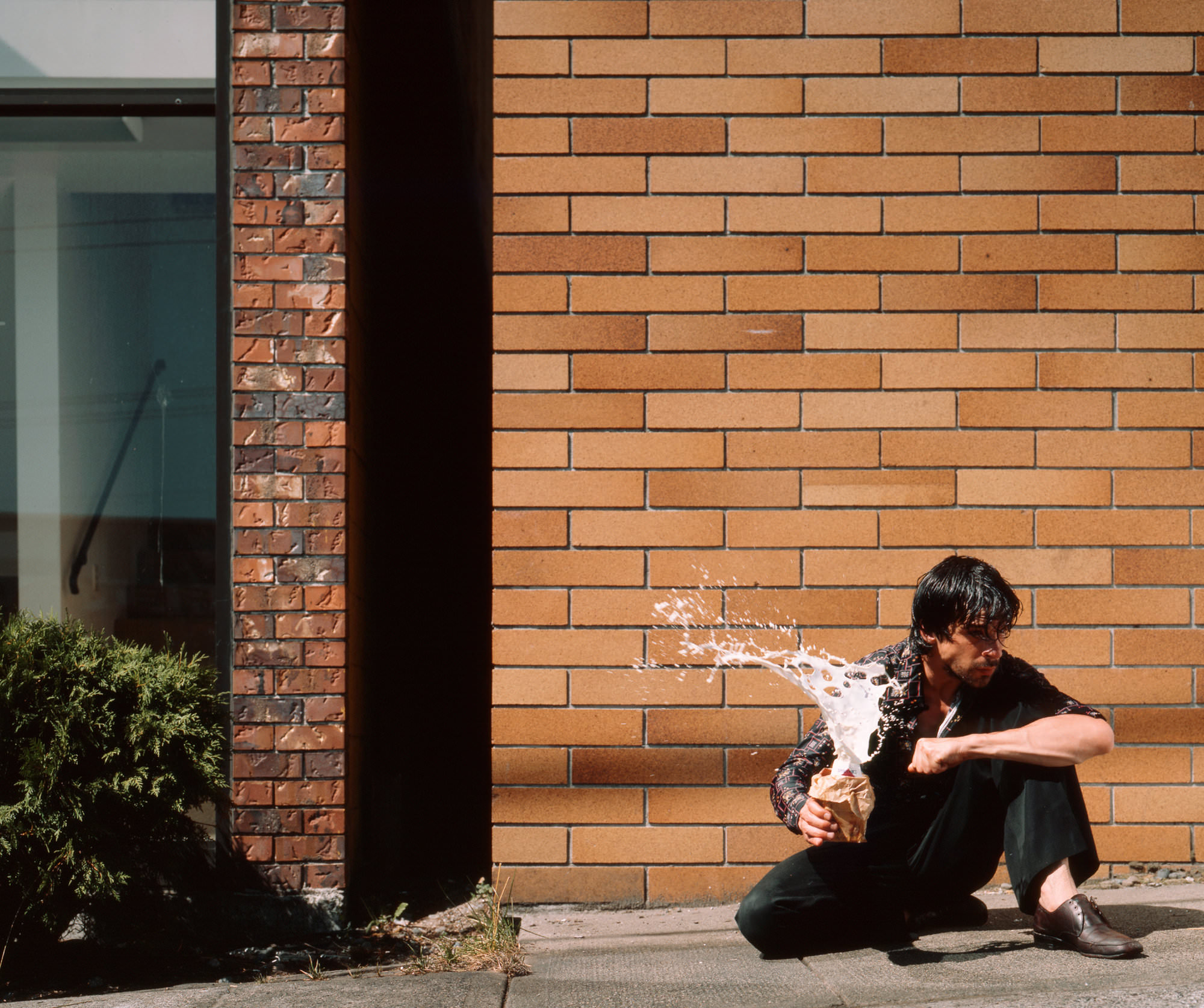 Jeff Wall. Milk, 1984. Photographic transparency in light box.
p. 7
In the opening line of his four-paragraph essay “Photography and
Liquid Intelligence,” photographer Jeff Wall directs the reader’s
attention to Milk, his light-box-illuminated Cibachrome transparency
of 1984. A study in planarity, Milk poses a man crouching
at street level before an architecture of bricked mensuration. The
figure grasps a carton of milk concealed in a paper bag. His forearm
is taut, jaw clenched; an outstretched, sockless shoe is stripped
of laces. From the container’s unfolded spout, white liquid spurts
upward to describe a half arc of interrupted, curving form against
the bricks’ relentless geometry. What has caused this explosion?
The grasping hand holding the carton gives no sign of the compression
required to create the spray, nor does the figure’s right
arm betray motion. For Wall, the image’s inexplicable action
becomes part of an allegory for photography itself. The optical
spaces of the photographic camera and enlarger make the stuff of
modern visuality: a “technological intelligence of image-making,
with the projectile or ballistic nature of vision when it is augmented
and intensified by glass (lenses) and machinery (calibrators and
shutters).”1 But, registering in Milk’s furling flows are the darkroom’s
shadowy pools of developers, fixatives, and washes required
for chemical photography’s visual activation. “I think of this
sometimes,” Wall writes, “as a confrontation of what you might
call the ‘liquid intelligence’ of nature with the glassed-in and
relatively ‘dry’ character of the institution of photography.”2 Where
the stasis of Milk’s tectonic planes is activated by fluid eruption,
so photography in this telling emerges as the yield between two
opposing modes of intelligence: dry and liquid, modern and
ancient, knowing and unknowable.
Jeff Wall. Milk, 1984. Photographic transparency in light box.
p. 7
In the opening line of his four-paragraph essay “Photography and
Liquid Intelligence,” photographer Jeff Wall directs the reader’s
attention to Milk, his light-box-illuminated Cibachrome transparency
of 1984. A study in planarity, Milk poses a man crouching
at street level before an architecture of bricked mensuration. The
figure grasps a carton of milk concealed in a paper bag. His forearm
is taut, jaw clenched; an outstretched, sockless shoe is stripped
of laces. From the container’s unfolded spout, white liquid spurts
upward to describe a half arc of interrupted, curving form against
the bricks’ relentless geometry. What has caused this explosion?
The grasping hand holding the carton gives no sign of the compression
required to create the spray, nor does the figure’s right
arm betray motion. For Wall, the image’s inexplicable action
becomes part of an allegory for photography itself. The optical
spaces of the photographic camera and enlarger make the stuff of
modern visuality: a “technological intelligence of image-making,
with the projectile or ballistic nature of vision when it is augmented
and intensified by glass (lenses) and machinery (calibrators and
shutters).”1 But, registering in Milk’s furling flows are the darkroom’s
shadowy pools of developers, fixatives, and washes required
for chemical photography’s visual activation. “I think of this
sometimes,” Wall writes, “as a confrontation of what you might
call the ‘liquid intelligence’ of nature with the glassed-in and
relatively ‘dry’ character of the institution of photography.”2 Where
the stasis of Milk’s tectonic planes is activated by fluid eruption,
so photography in this telling emerges as the yield between two
opposing modes of intelligence: dry and liquid, modern and
ancient, knowing and unknowable.
A dry, ballistic intelligence of technological modernity might
seem abundantly familiar to readers of Grey Room. What of “liquid
intelligence”? Contemporary prompts for sounding it are found
easily enough. Before any talk of drip or pour paintings, liquid word
pictures, the abject viscosities of the informe and other art-world
stalwarts, the phrase could call to mind the “liquid modernity”
used to denote our deracinated, deregulated era.3 The melting of p. 8
solids prophesized by Karl Marx and Friedrich Engels has been
held in suspension, according to the late Zygmunt Bauman, for
the exercise of “increasingly mobile, slippery, shifty, evasive and
fugitive power.”4 Mobilizing the digital age’s ubiquitous palette
of the liquid crystal display, some technophilic campaigners have
called for a “liquid democracy” to replace representational politics
with referendum-based interventions.5 If various forms of
fluidity and plasticity can be traced through the choppy currents
of post-Lacanian feminism, deconstruction, and cognitive neuroscience,
then the rising sea levels, melting ice caps, and desolation
of the oceans’ biosystems—environmental catastrophes
signaled, too, in Wall’s pithy essay—will soon make practical
recourse to liquid intelligence matters of urgent necessity.6
But Wall’s essay also opens away from the present. An
“archaism of water, of liquid chemicals,” liquid intelligence
connects photography to the past, to time, in an important way. By calling water an “archaism” here I mean that it embodies a memory-trace of very ancient production processes—of washing, bleaching, dissolving and so on, which are connected to the origin of technè—like the separation of ores in primitive mining, for example. I think that this “prehistorical” image of photography—a speculative image in which the apparatus itself can be thought ofas not yet having emerged from the mineral and vegetable worlds—can help us to understand the “dry” part of photography differently.7
What would it mean to imagine a broader genealogy of liquid
intelligence informed by the expansive technical history Wall
evokes? Wall has hardly been alone in exploring alternate prehistories
of photography, but this special issue proceeds from
the proposition that liquid intelligence has already been unconsciously
afoot in recent histories of the arts and architecture of
early modernity.8 So, how might that congealing conversation be
shaped? And what does it tell us? This introduction sets the
table with “Curve/Line/Circle,” an allurement that bleeds
between recent historiography and historical materials to diagnose
the slippery ways in which figurations of the fluid are with
us now. Moving with Gaston Bachelard’s alignment of water and
dreams, “Slash/Cross” frames the stakes of the inquiry in
chiaroscuro textures of nightmare. Yet, as bathos, too, can be
ground for action, a concluding diagram sets out the special
issue’s program and its prospects in firmer terms.
Curve/Line/Circle
Guided by interdisciplinary currents of a “new thalasography,”
a point of entry to liquid intelligence might plausibly be found p. 9 at the greater confluence of the Mediterranean and Black Seas in the fabric of the Hagia Sophia—its architecture acting as a giant
acoustic resonator to meld human voices into an oceanic
murmur; its book-matched marble pavements simulating a vast
expanse of water as a “horizon on which human finitude is set
between lucid firmness and umbrous chaos.”9 Yet, outward from
Milk’s curving streams, a tale could equally be told in diagrammatic
terms, moving first from line to circle.10 After all, the edifice
of northern Renaissance image-theology was built, by Joseph
Koerner’s reading, on the backs of unctuous figures: miraculous
pictures dragged off the surface of ponds or the sudarium (sweat
cloth) pulled from the face of Christ by St. Veronica in the contact
relic that would take her name.11 Found not fabricated; made
without the intervention of human hand, the moist imprint of
Christ’s face gave theological sanction to figural depiction in an
era increasingly suspicious of graven images. And working in the
medium of oil paint that Jan van Eyck had mythically invented
in the early fifteenth century as he turned from the sun that
ruptured his drying pictures to the dark, controllable spaces of
“alchemy and distillation,” Albrecht Dürer audaciously replaced
the sudarium’s holy face with his own visage, the human face of
a Christ-like painter.12 Koerner traces this line as a volte-face, “a
kind of Copernican revolution of the image.”13
Fluids brought into line by a virtuosic self could thus move
away from Michel Foucault’s orders of similitude to draw the
bounds of Renaissance intelligence anew.14 In Michael Cole’s
reading, Benvenuto Cellini is neither the paragon of Jakob
Burckhardt’s uomo universale, nor was his training as a goldsmith
merely some perfunctory prolegomenon for entry into
Giorgio Vasari’s arts of disegno. Instead, Cellini’s command of the
technics and poetics of poured, molten metals amounts to a
“goldsmith’s intelligence,” which ensnares rivals working in
subtractive media while elevating the art of cast bronze.15 By
scriptural tradition, the casting of metals had been redolent with
an animism materialized in nothing less than the ur-idol of the
Golden Calf. “‘I threw it into the fire, and out came this calf!’”
(Exodus 32:24)—so Aaron protests to Moses after gathering and
liquefying the Israelites’ golden jewelry. By contrast, Cole’s
Cellini moves with the “artisanal epistemology” through which
command over materials earned by bodily blood, sweat, and tears
came to rival textual learning as a legitimate source of natural
knowledge.16 Arrogating the capacity to create and not simply
replicate nature’s forms, this tradition could figure the artist’s
brain as “a moist organ, in which the movement of fluids propelled
the creation of thoughts and the recollection of memories.”
17 Such brawny intelligence would find an organizing theme
in what Cole calls “the control of liquids.”18
p. 10
Channeling flow into line also meant parsing—policing—
liquid intelligence from deluding, deceiving waters. Faced with
the challenge of Caravaggio’s so-called naturalism and the serial
replication augured by the printing press, Nicolas Poussin
looked to fluids in the mid-seventeenth century. With their
watery pools dumbly doubling figure and sky, Richard Neer
claims, Poussin’s mythological landscapes stage the imminent
danger: “Just as mechanical reproduction is the ‘sepulchre’ of
painting, just as pictorial realism turns artists into animals, so …
the sterile mimicry of Narcissus and Echo results in the loss of
both life and humanity.”19 Consigned to the narcissistic order
of death that Poussin called “aspect,” watery reflection stands in
counterpoint to the reasoned order of “prospect” and a generative,
emulative mode of allegorical imitation that the painter
figures around the rebirth of the wine-god Bacchus in a moist
grotto. In Paradise Lost (1667), John Milton’s Eve first wakes to
gaze upon Eden’s waters: “Smooth lake, that to me seemed another
sky.” Staring down into that fluid world, she sees “a shape
within the wat’ry gleam … with answering looks / Of sympathy
and love.”20 Like Poussin, Milton’s Adam seeks to break liquids’
specular spell. He identifies “that smooth wat’ry image” with
Eve herself and contrasts it to a fluid order he will install. “Follow
me,” Eve recalls Adam charging, and “… thou shalt bear /
Multitudes like thyself, and thence be called / Mother of the
human race.”21 Inseparable from the pretensions of a hereditary
nobility, a parsed, purified line of genealogical descent distinguished
from the deluding, diluted pool would
reach an apex in rituals of absolutist statecraft.
22 From the octagonal space of his grande
laiterie within Versailles’s 1660s menagerie,
Meredith Martin argues, Louis XIV poured
milk and offered dairy consumables to a politically
gelded nobility. Attesting to the purity of
the Bourbon bloodline and his own fructifying
force, Louis’s performances claimed “women
and gardens as raw materials for his own (male)
production. The grande laiterie took up where
these female allegories left off, as a womblike
space that he could utilize to transform the red
blood of war into the white milk of peace.”23
But, a liquid intelligence in seventeenthcentury
conception could not bend only to
linear circumscription. Anatomizing an ark of
serpents, frogs, snails, dogs, and pigs, royal
physician William Harvey pursued the motion
of the heart’s ventricles to a new geometry of
blood, “a movement, as it were, in a circle.”24 Figure 2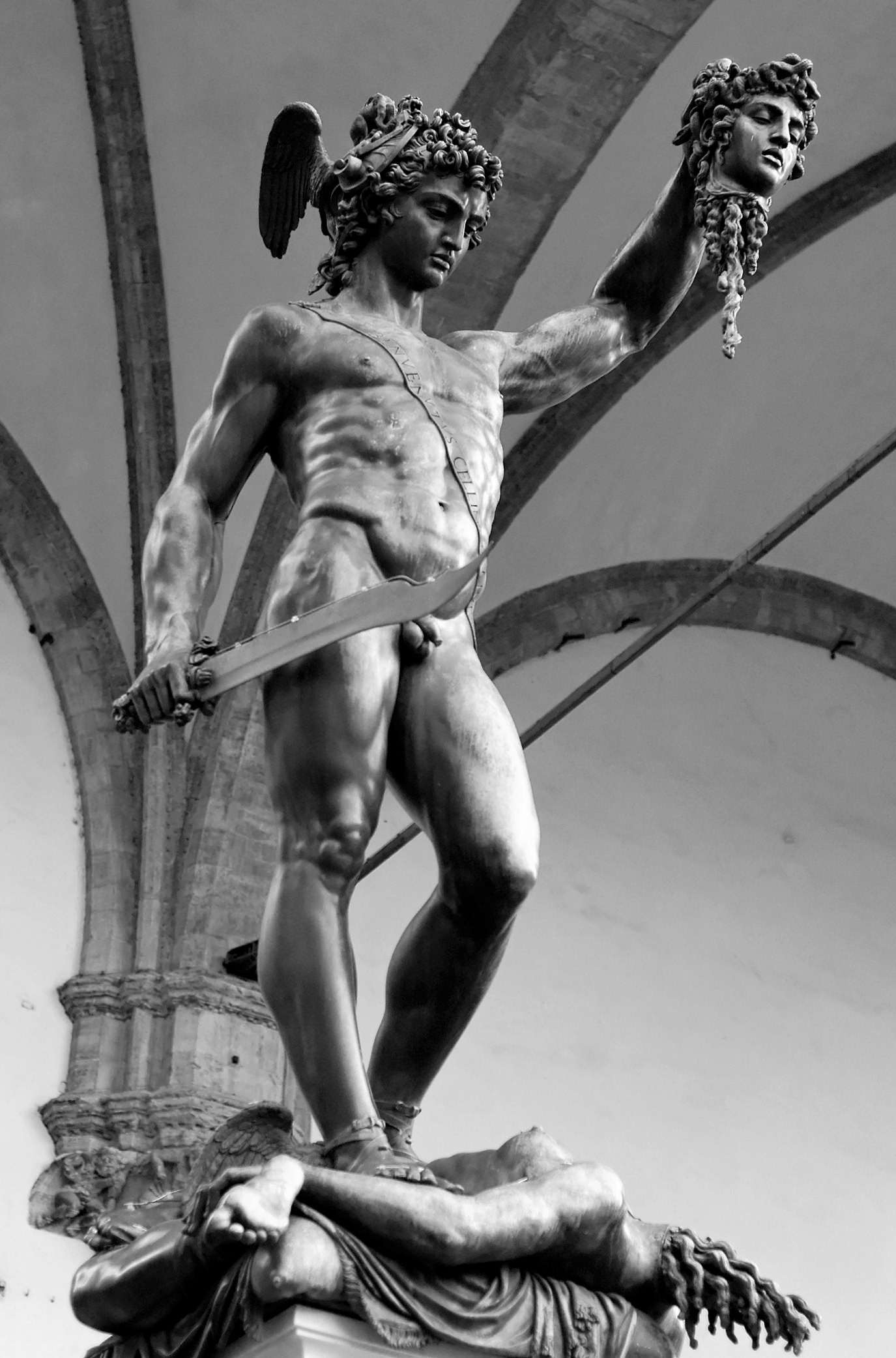 Benvenuto Cellini.
Perseus and Medusa,
ca. 1545–1554. Cast bronze. Figure 3
Benvenuto Cellini.
Perseus and Medusa,
ca. 1545–1554. Cast bronze. Figure 3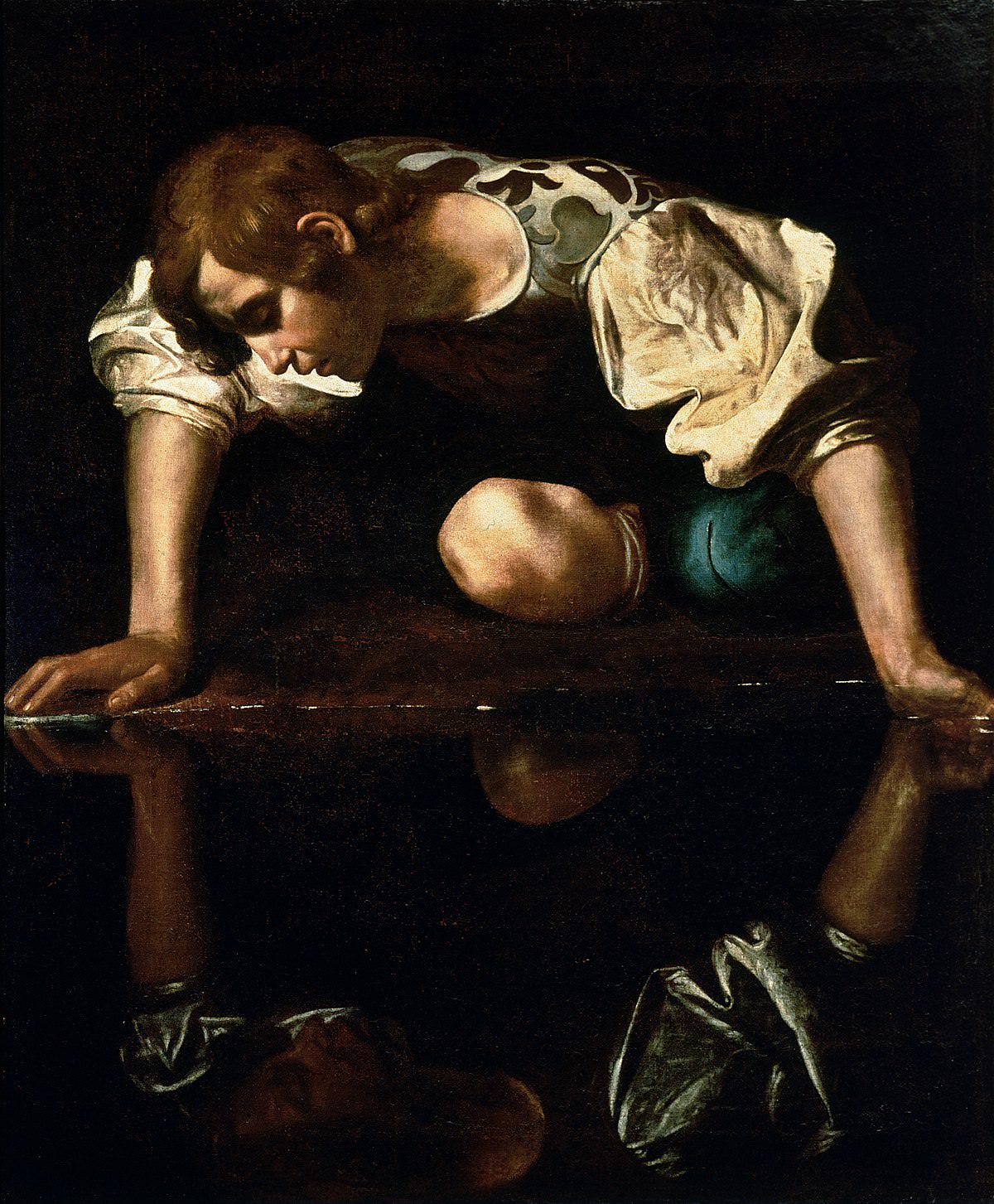 Michelangelo Merisi da Caravaggio. Narcissus, 1597–1599. Oil on canvas. p. 11 Frédéric Cousinié commensurately envisages “a general economy
of fluids characterized by mobility, convertibility, and reciprocal
exchange” at the heart of seventeenth-century French
painting.25 In that age of fen draining and corporate water supplying,
such circulatory models might equally be seen as paradigmatic
to the political anatomy of intelligence.26 Oxford-based
physiologist Thomas Willis (father of our “neurocentric age,” as
one writer puts it) excavated the eponymous, cerebral “Circle of
Willis” to disclose a fluid infrastructure of thought’s pulsing
movement.27 With “the Fountains of the Primary Spirits …
placed in the top it self of the Body,” so Willis argues with terms
taken from chemical instrumentation, the brain distills animal
spirits off from the blood, which then cascade down through the
corporeal frame “as it were by Bills and Pelicans placed here and
there, into all the inferiour parts” to be cycled back up again.28
For Willis’s understudy Robert Hooke that circulatory pattern
was as much social as it was physiological. True philosophy,
Hooke claims,
Michelangelo Merisi da Caravaggio. Narcissus, 1597–1599. Oil on canvas. p. 11 Frédéric Cousinié commensurately envisages “a general economy
of fluids characterized by mobility, convertibility, and reciprocal
exchange” at the heart of seventeenth-century French
painting.25 In that age of fen draining and corporate water supplying,
such circulatory models might equally be seen as paradigmatic
to the political anatomy of intelligence.26 Oxford-based
physiologist Thomas Willis (father of our “neurocentric age,” as
one writer puts it) excavated the eponymous, cerebral “Circle of
Willis” to disclose a fluid infrastructure of thought’s pulsing
movement.27 With “the Fountains of the Primary Spirits …
placed in the top it self of the Body,” so Willis argues with terms
taken from chemical instrumentation, the brain distills animal
spirits off from the blood, which then cascade down through the
corporeal frame “as it were by Bills and Pelicans placed here and
there, into all the inferiour parts” to be cycled back up again.28
For Willis’s understudy Robert Hooke that circulatory pattern
was as much social as it was physiological. True philosophy,
Hooke claims,
is to begin with the Hands and Eyes, and to proceed on
through the Memory, to be continued by the Reason; nor
is it to stop there, but to come about to the Hands and
Eyes again, and so, by a continual passage round from one
Faculty to another, it is to be maintained in life and
strength, as much as the body of man is by the circulation of
the blood.29 Figure 4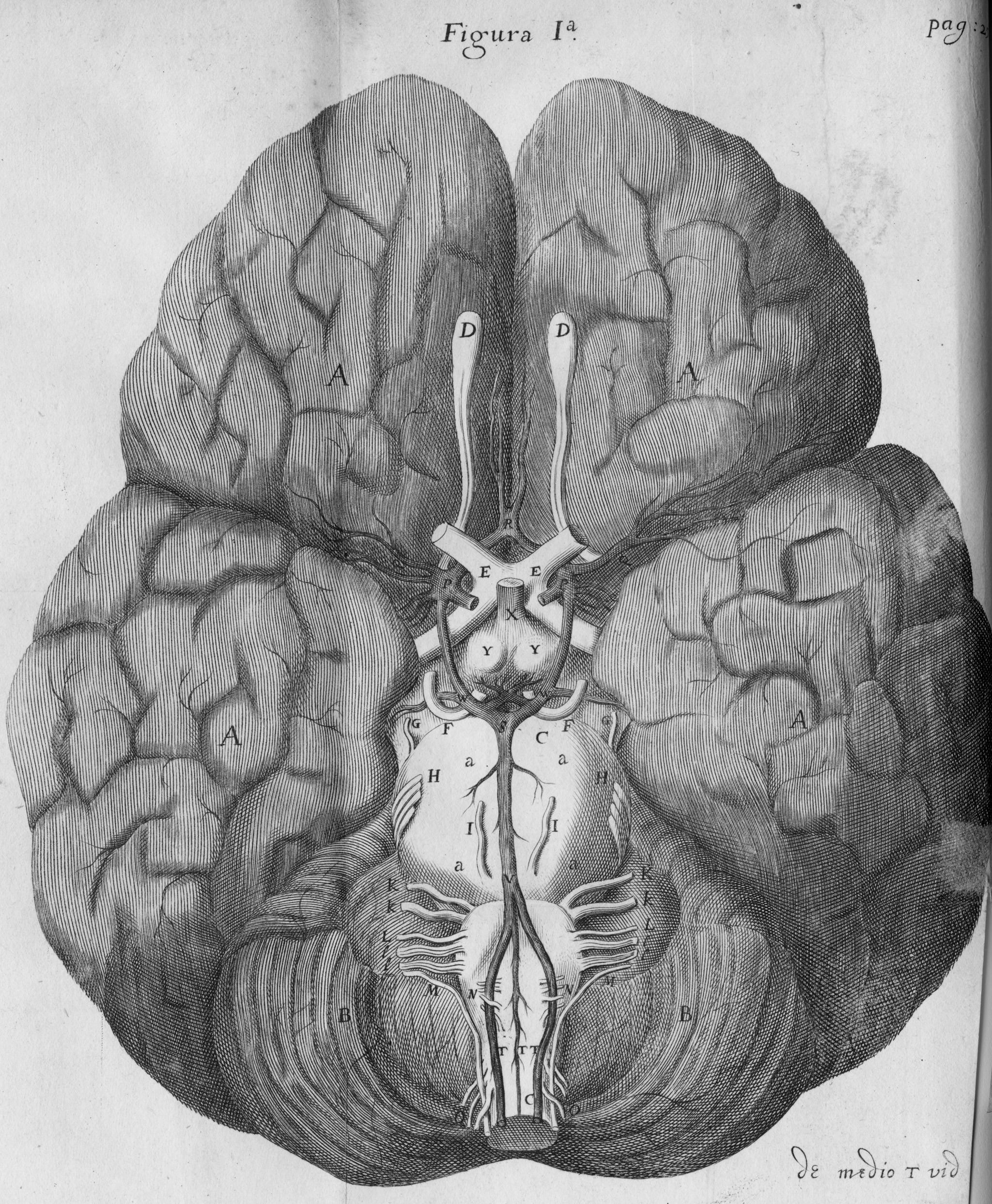 Unknown maker after Christopher Wren. The “Circle of Willis,” from Thomas Willis, Cerebri Anatome (1664).
Etching and engraving.
Unknown maker after Christopher Wren. The “Circle of Willis,” from Thomas Willis, Cerebri Anatome (1664).
Etching and engraving.
Knowledge could not simply be
handed down in a vertical line from
professor to student; it could grow
in vitality only as it circled between
capacities and social stations.30
Nowhere would that force of the
circle and its movement beyond
the order of the line become more
ubiquitous than in Enlightenment
conversations about political economy.
Literary historian James
Thompson identifies a key double
movement in the period’s conception
of money: shifts from bullion
value weighed to nominal value to
be read and from stable treasure
to be horded into capital increased
by movement.31 For Thompson,
the campaign of philosopher John
Locke to restore England’s corrupted
coinage to its Elizabethan p. 12 weight-values exemplifies a materialist, conservative “law of
continuity: that material substance is the same from moment to
moment… . [which] is, of course, the most cherished principle
of landed aristocracy—that the paternal estate is bounded by the
same hedgerows through the centuries.”32 By contrast, a nominalist,
capitalist vision that consolidated throughout the eighteenth
century would figure circulating currency as means for
nourishing economic growth as a river does parched earth.33 From
a grounding in land to the fluids that replenish it, money in
Adam Smith’s An Inquiry into the Nature and Causes of the
Wealth of Nations (1776) is “a sort of waggon-way through the air;
… [enabling] the country to convert, as it were, a great part of its
highways into good pastures and cornfields, and thereby to increase
very considerably the annual produce of its land and labour.”34
In the hands of Svetlana Alpers and Michael Baxandall, that
positive potential for fructifying, circulatory movement defines
eighteenth-century “pictorial intelligence.” Venetian painter
Giovanni Battista Tiepolo moves a fluid aesthetics of lightness
and mobility to the center of his project.35 Studying the “freakish
intermittent effect” of moving water reflecting off the ceiling
designs that Tiepolo painted quickly into wet plaster intonaco,
Alpers and Baxandall find pictorial programs built in collaboration
with, not suppression of, complex interplays of light bouncing
off the surfaces of Venice’s canals.36 Where Tiepolo’s pictorial
intelligence “postulates a mobile light and … a mobile viewer,”
it positively chafes under constraints to its freedom. Inert
illumination from infelicitous architecture or “paralysing” quadratura
frames variously “straightjacketed” and “locked” its “fluid
potentiality.”37 Whether or not Tiepolo and his patrons could
have subscribed to the tenets of Smith’s political economy,
intelligent handling of the Enlightenment
painter’s art had, by this account, come to
entail negotiation with circulating patterns
and the “free,” value-adding contribution of
the beholder they imply.
By the lights of recent scholarship, then,
it is not sufficient to say that eighteenthcentury
liquid intelligence modeled the
beholder as a ship sailing under some “bluewater”
policy.38 Artists such as John Singleton
Copley show how profoundly the venerable
analogy of the painting-as-ship was then
sounded when contemplating pictorial
ontology itself.39 By Jennifer L. Roberts’s
reading, Copley “spent the first ten years of
his life in his mother’s tobacco shop on
Long Wharf, an immense pier jutting … p. 13 a quarter of a mile into the center of Boston Harbor. Copley
would have awakened each morning to a noisy, smelly, colorful
panorama of merchant shipping activity.”40 That embodied,
multisensorial nous provided Copley with the logistical wherewithal
to ship his Boy with a Flying Squirrel (1765) across the
Atlantic to unknown exhibitors in London, but Copley’s understanding
of the precarious nature of the attempted oceanic relay
pervades the exported picture’s iconographic program and visual
form. If modeled on the age of sail, Copley’s “parcellated, modularized,
dehydrated, pickled, or pressed” pictures would soon be
usurped by an intelligence calibrated not to water’s liquid form
but to its gaseous state: to steam.41 This is the story Michel Serres
tells around Joseph Mallard William Turner, “the first real genius
of thermodynamics.”42 Serres opposes Turner’s obsessions with
“the furnace, the water, the hot and the cold, matter in fusion” to
the classical-mechanical world of applied geometries essential
to wind-borne sailing ship’s calculations.43 Where contemporary
painter of the apocalyptic landscape John Martin would envision
engineering schemes to recycle the Thames’s sewage into agricultural
fertilizer, Turner turns liquid intelligence into the terms
of a different physics: “perception on a stochastic basis has replaced
the drawing of form.”44Figure 5 J.M.W. Turner.
The Burning of the Houses
of Lords and Commons,
16 October, 1834, 1835.
Oil on canvas.
J.M.W. Turner.
The Burning of the Houses
of Lords and Commons,
16 October, 1834, 1835.
Oil on canvas.
This sense of an altered regime between the eighteenth century
and the era augured by thermodynamics is palpable in the
work of Michael Fried, for whom liquid intelligence has been a
direct object of reflection.45 In the early decades of the eighteenth
century, quiet scenes of concentrated attention on the everyday—
scenes of “absorption” (a term not without fluid resonance)—as p. 14 rendered by Jean-Baptiste-Siméon Chardin had spoken of what
Fried calls “not … time wasted but of time filled (as a glass may
be filled not just to the level of the rim but slightly above).”46 The
crisis of that “absorptive tradition” by the middle decades of the
nineteenth century would be epitomized by the strange uses
made of liquids in the art of Gustave Courbet. In Courbet, water
figures “as a natural metaphor of continuity, of the spilling-over
of the contents of the painting into the world of the beholder,
and therefore of the incapacity or the refusal of the painting to
confine its representation (to confine itself) within hard-and-fast
limits.”47 Welling, streaming, pooling into the nether regions of
his portraits and landscapes, Courbet’s waters render his canvases
just as inscrutable as the “boggy, soggy, squitchy picture” that
vexes Ishmael at Herman Melville’s Spouter-Inn.48 “The bottom
edges of his paintings,” Fried writes, “have a problematic status
unlike anything to be found in the work of any painter before or
since.”49 The proposition here is that Courbet could neither
simply ignore the beholder before the painting nor sustain with
drama the fiction of the picture’s self-enclosure to negate the
force of a beholder’s presence. Where Chardin achieved absorption
by rendering liquids in their brimming fullness, Courbet
musters flows that carve out those soggy pictorial bottoms while
figuring a flood of the painter’s own reciprocal movement into
his painted world.50 An ingenious solution to absorption’s crisis,
Courbet’s circulating, colliding fluids ford what Fried labels “the
ontological impermeability of the picture surface, by which I
mean its standing as an imaginary boundary between the world
of the painting and that of the beholder.”51 Liquidating the
bottom edge and surging in, Courbet realizes himself not before
his pictures but inside them. Overstepping the line, the circle
is again closed.
Slash/Cross
Friedian sanction alone may be sufficient to sink, scupper, or
slash liquid intelligence from the concerns of some readers.
Those are not the only grounds for hesitation. In 1964, Britishborn
psychologist Raymond Cattell (1905–1998) added to a
mountain of research contributions—what would eventually
become some fifty books, five hundred journal articles, dozens
of testing protocols—an enduring bifurcation in the analysis of
human intelligence. Cattell parsed general intelligence (g) into
what he called “fluid” and “crystallized” intelligence (or gf and
gc). By this account, fluid intelligence is expressed most clearly
in situations demanding improvisation and adaptation, where
skills learned by habit are of little avail. Cattell writes,
For any same-age group the nature-nurture variance ratio
will be much higher for gf than gc on the hypothesis that gf p. 15 is directly physiologically determined whereas gc is a product
of environmentally varying, experientially determined
investments of gc… . However, although it is our hypothesis
that gf is biologically and physiologically determined, as a
function of total cortical cell count, this does not mean that
one would expect anything like complete hereditary determination.
For environment includes gestation period influences
and later physical trauma and physiological change,
all affecting gf.52
Speaking to Cattell’s larger contribution to multivariate factor
analysis in the study of human personality, this bifurcation has
had profound influence. “A landmark contribution, cited not only
in every book on intelligence but also in numerous introductory
psychology books,” one recent interpreter notes, “the separation of
fluid and crystallized intelligence has been one of Cattell’s most
enduring substantive contributions of psychology.”53
Multiple variants aside, heredity plays a forceful role in
Cattell’s thinking. Not only is the fluid more nimble than crystallized
intelligence, but it also abides where crystallized, book
learning decays, and is, in a sense, always already dead: “If the
crystallized abilities are, as it were, a dead coral formation revealing
by its outlines the limits of growth of the original living
tissue, the crystallized abilities will show approximately the
same intercorrelations as the original fluid abilities.”54 When correlating
tabulated data of gf and gc, Cattell declines the possibility
that these two modes of intelligence combine in some new
form. Instead, they need to be read through “a single influence,
which is fluid ability as it stood during the formative period of
crystallized ability, [that] is causative to the present levels of
both.”55 Living, physiologically inflected, and heritable, fluid
intelligence describes a threshold of possibility that can be analyzed
in the decaying crystallized artifacts of which it is itself a
significant cause.
Cattell was a committed eugenicist.56 As historian William H.
Tucker argues, Cattell shared with mentors Charles Spearman,
Cyril Burt, and William McDougall
the belief in the power of heredity as an article of faith necessary
for justification of the eugenic agenda, more than as a
scientifically demonstrable result. In 1938, discussing the
deleterious social effects that would be caused by the disproportionate
reproduction of the less intelligent, Cattell
declared it an accepted fact that “mental capacity is largely
inborn.”57
Even if, as he would write in 1964, that “does not mean … complete
hereditary determination,” the fluid capacity animating the
crystallized intelligence derived from it is still significantly p. 16 informed by genetic transfer through sexual reproduction. It
flows with the blood.
Wall is a bookish artist. While Cattell’s name is largely unknown
in the history of art (a field in which Wall pursued postgraduate
work at London’s Courtauld Institute of Art), the ubiquity of his
fluid/crystallized dynamic makes a connection to Wall’s copycat
binary at least possible. Even without pressing on any direct
linkage, though, the shadow of Cattell’s ideas puts Wall’s choice
of Milk as framing image for “Photography and Liquid Intelligence”
in a new light. Modeled by that lactic fluid prompted by mammalian
gestation, Wall’s conception of photography as product
of wet, immersive, incalculably curvy intelligence meeting dry,
projectile rationality plots the medium through a matrix of
ancient, humoral theories, casting it in the sexual-reproductive
mold underpinning Cattell’s logics. Rather than tarring Wall with
Cattell’s eugenicist brush in some specious guilt-by-terminologicalassociation,
though, the salient point is to highlight the fundamental
continuity of both with the sexualized, heteronormative
terms to which thinking about replication in photography and
other arts is thoroughly addicted.58 To extend Julian Stallabrass’s
critique, the frictionless, fluid cohesion of Wall’s liquid intelligence
with conservative, institutionalized patterns of thought—
along with his pictures’ abundant references to canonical art—
are what make his work such catnip for art historians and museum
taste-makers.59
Enthrallment to the terms of liquid intelligence would thus be
more than just another slippery seduction by what Walter Benn
Michaels calls “neoliberal aesthetics.”60 Instead, a geometry of
curve, line, circle, and slash might fittingly end in a cross: Noah
Cross. In the Bible, Noah saves terrestrial life as he rises with the
waters of the Flood. Noah Cross, Roman Polanski’s infamous
Nobodaddy in Chinatown (1974), played by John Huston, controls
the flow of water to drought-stricken Los Angeles. Like the
maimed, dying Fisher King of Grail legend, Cross is frail; he
walks with a cane and reads with bifocals. Jack Nicholson’s
would-be knight errant, Jake Gittes, hangs totemic portraits of
horses above his bed. Chivalric sculptures adorn the shelves in
his office, where he signs financial contracts to investigate dirty
deeds. Cross holds court at the Albacore Club, a massive tuna as p. 17 its ensign. Gittes trades in bourgeois instruments of credit; he
takes checks and follows flows of water while trying to apprehend
what he takes to be Cross’s financial motives. Yet, like the
fatal puncture of Evelyn Mulwray’s eyes at the film’s climax,
Gittes remains blind to the primeval flow of semen that binds
Cross to the daughter he has fathered through another daughter.
Paid to recover what he thinks is a missing mistress, Gittes and
his circulating thoughts of money unwittingly deliver the grail—
not an object but a bloodline to the future—back to the Fisher
King.61 By giving ourselves over to the contemplation of liquid
intelligence, are we not already plotted into the patsy role of
Gittes by forces we can never understand? Figure 6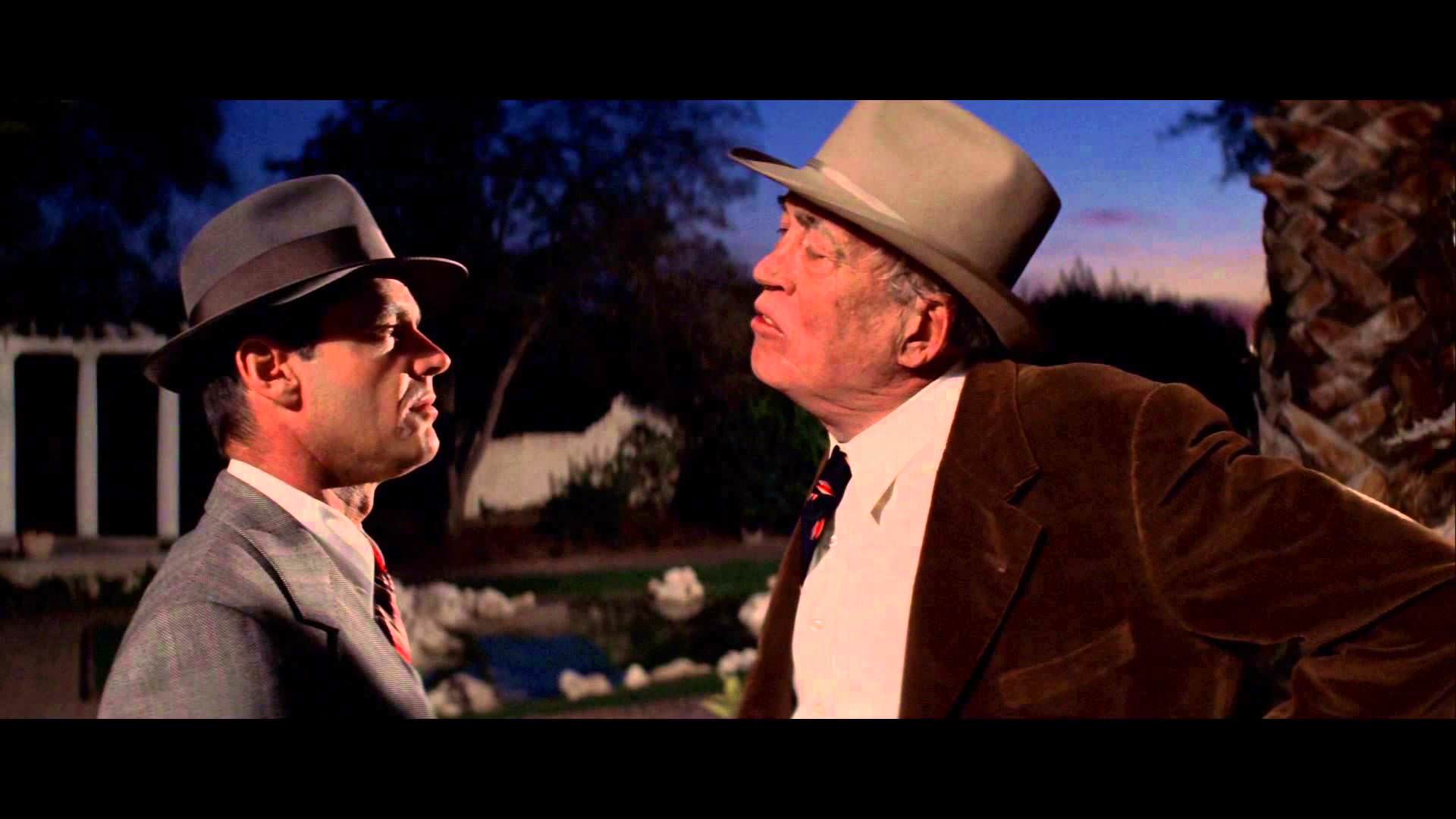 Roman Polanski,
dir. Chinatown, 1974.
Frame enlargement.
Roman Polanski,
dir. Chinatown, 1974.
Frame enlargement.
A Diagram of Action
Resources are, however, to hand by which to rescue inquiry from
these nightmares. In Vampyroteuthis Infernalis (1987), Vilém
Flusser and collaborating graphic artist Louis Bec turn to the
oceans’ crushing, sightless depths to reimagine as much the
literary form of the scientific treatise as human reason remapped
through the hallucinatory chromatophores and tentacles of the
cephalopod body, itself “a centripetal and enclosed whirlpool, a
vacuum within its environment that is released as a jet of water
to propel it backwards.”62 Figure 7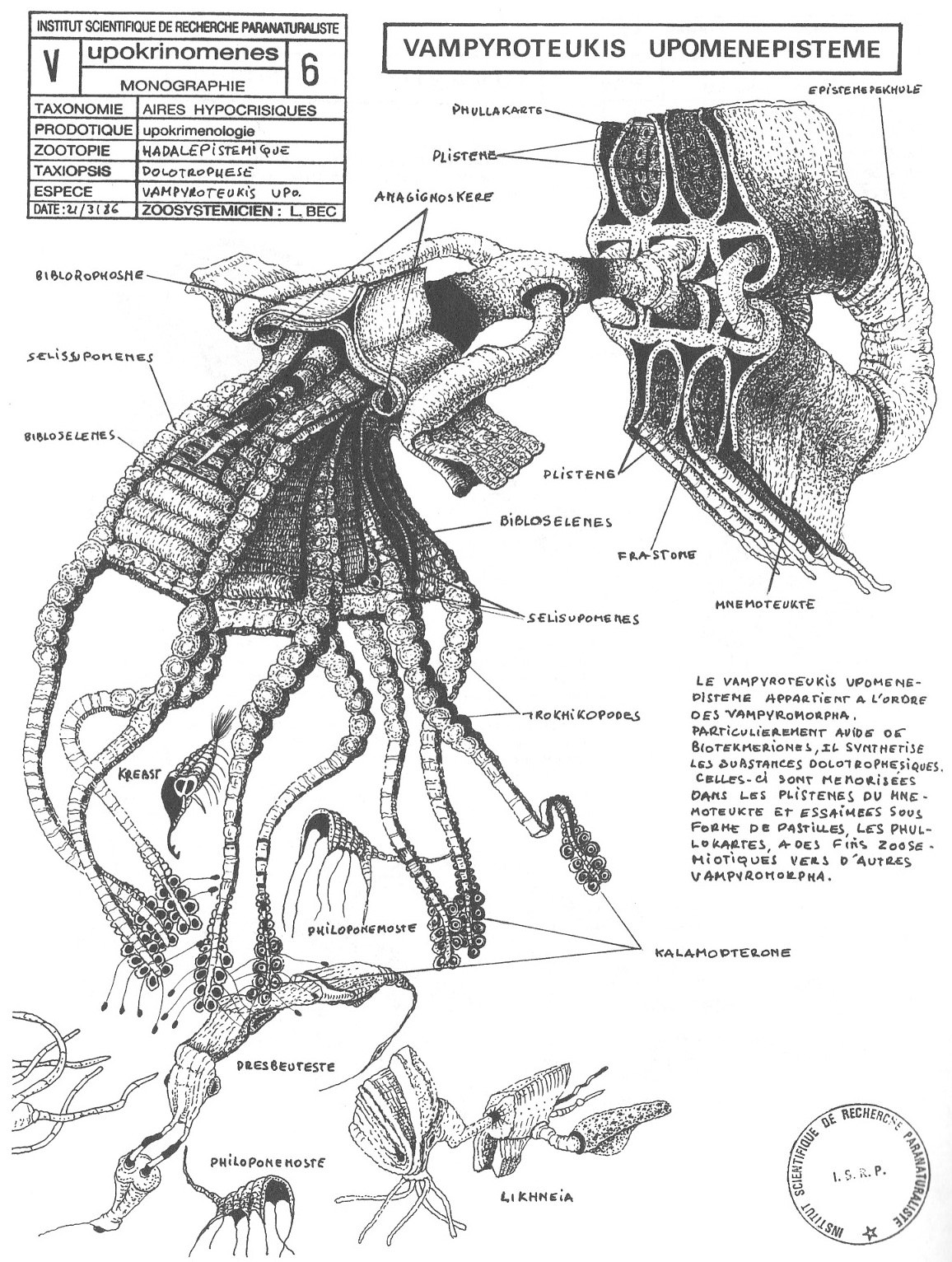 Louis Bec.
Vampyroteukis Upomenepisteme,
from Vilém Flusser and Louis
Bec, Vampyroteuthis Infernalis
(1987). Pen and ink. In more sober terms, Peter Godfrey-
Smith looks to the body of the octopus to map philosophical
problems of mind anew. Disabusing Cartesian tics of human
thought, octopoid form takes little stock of an elevated, isolated
brain, since “it’s not clear where the brain
itself begins and ends, and the nervous
system runs all through the body. The
octopus is suffused with nervousness;
the body is not a separate thing that is
controlled by the brain or nervous system.”
63 Where these approaches study
intelligences in waters to work beyond
the humanoid horror of Polanski’s Cross,
this special issue of Grey Room faces its
baleful figures by different means. The
included essays take as axiomatic that
liquid intelligence is neither exclusive
to thoughts about Wall nor to photography
per se. Rather, they operate from the
proposition that critical histories of
what John Harwood calls “epistemologies
of mutability”—rationalities, logics,
and intelligences of fluids—can and
must be drawn rigorously out into the
light of day. Wall and his terms are our p. 18 prompts for opening such an inquiry.
The collection begins in medieval China, where Jeffrey Moser
highlights a development of modern porcelain at the industrialscale
kilns of Jingdezhen that was predicated on systematic
elimination of chance from the firing process. Jingdezhen porcelain
relied on the continuity of human agency throughout the
firing process to achieve its hallmark aesthetic of fine-lined
designs under clear glazes on pure, white bodies. To that consolidating
episteme of predictive manufacturing, uncontrolled
effects—starbursts of ruptured minerals, pendulous gobs of
molten glaze, sparking lines of crazed glass—came to be understood
under the capacious rubric of yaobian (kiln transformations).
Although scantly recorded in the textual record, the
material products of this older mind-set survive in abundance in
the “oil spots” and “hare’s fur” of Jian ware tea bowls, the azure
“worm tracks” of Jun ware planters, and the crackles of Guan ware
celadons. Moser argues for the value of “liquid intelligence” as
an analytical mechanism by which to develop a vocabulary
sufficient to represent the complex processes of stimulating
serendipity that generated these wares.
Louis Bec.
Vampyroteukis Upomenepisteme,
from Vilém Flusser and Louis
Bec, Vampyroteuthis Infernalis
(1987). Pen and ink. In more sober terms, Peter Godfrey-
Smith looks to the body of the octopus to map philosophical
problems of mind anew. Disabusing Cartesian tics of human
thought, octopoid form takes little stock of an elevated, isolated
brain, since “it’s not clear where the brain
itself begins and ends, and the nervous
system runs all through the body. The
octopus is suffused with nervousness;
the body is not a separate thing that is
controlled by the brain or nervous system.”
63 Where these approaches study
intelligences in waters to work beyond
the humanoid horror of Polanski’s Cross,
this special issue of Grey Room faces its
baleful figures by different means. The
included essays take as axiomatic that
liquid intelligence is neither exclusive
to thoughts about Wall nor to photography
per se. Rather, they operate from the
proposition that critical histories of
what John Harwood calls “epistemologies
of mutability”—rationalities, logics,
and intelligences of fluids—can and
must be drawn rigorously out into the
light of day. Wall and his terms are our p. 18 prompts for opening such an inquiry.
The collection begins in medieval China, where Jeffrey Moser
highlights a development of modern porcelain at the industrialscale
kilns of Jingdezhen that was predicated on systematic
elimination of chance from the firing process. Jingdezhen porcelain
relied on the continuity of human agency throughout the
firing process to achieve its hallmark aesthetic of fine-lined
designs under clear glazes on pure, white bodies. To that consolidating
episteme of predictive manufacturing, uncontrolled
effects—starbursts of ruptured minerals, pendulous gobs of
molten glaze, sparking lines of crazed glass—came to be understood
under the capacious rubric of yaobian (kiln transformations).
Although scantly recorded in the textual record, the
material products of this older mind-set survive in abundance in
the “oil spots” and “hare’s fur” of Jian ware tea bowls, the azure
“worm tracks” of Jun ware planters, and the crackles of Guan ware
celadons. Moser argues for the value of “liquid intelligence” as
an analytical mechanism by which to develop a vocabulary
sufficient to represent the complex processes of stimulating
serendipity that generated these wares.
Jennifer L. Roberts turns to nature-printed paper currency
developed in the 1730s by Benjamin Franklin in collaboration
with the botanist Joseph Breintnall. In the decades following
their experiments, much of the paper money circulating through
the mid-Atlantic colonies would feature elegant prints of maple,
sage, parsley, blackberry, and other leaves. Because the leaves’
delicate and random vein structures could not be engraved by
hand, they served as effective anticounterfeiting protection. Roberts
contends that liquid intelligence informed these notes at every
level: from the veins as natural structures for the movement of
moisture through the leaf, to the economic “circulation” enabled
by paper currency, and on to the liquidities that determine the
constitutive acts of printing itself (the casting in liquid metal and
plaster needed to mold the leaf matrices to the channeling of
liquid ink). Franklin’s notes, Roberts proposes, are revealingly
poised on the edge of a fundamental ambiguity within the concept
of liquidity as, alternately, an aleatory, material, fluid activity
beyond the grasp of rational systems and, on the other hand, a
state of controlled and predictable financial convertibility.
Matthew C. Hunter’s contribution opens on the opposite side
of the Atlantic with the extensive contacts between arbiters of
British sea power and Joshua Reynolds, first president of the
Royal Academy of Arts. Backed by the steady patronage of a
West Country elite centered on the port city of Plymouth,
Reynolds sailed to Italy and returned to metropolitan artistic triumph
in the early 1750s with Captain Augustus Keppel, whom
the painter styled as an eighteenth-century Apollo. Alongside p. 19 his slew of classical postures, however, Reynolds also imported
into the heart of Britain’s school of painting an appetite for secretive
formulas, nostrums, and experimental pigments—obsessions
that would earn Reynolds the epithet “Sir Sloshua” among Pre-
Raphaelite critics in the nineteenth century. Moving between the
material epistemologies studied by recent historians of science
and a juridico-actuarial framework then emerging to defray risk,
Hunter’s essay frames Reynolds’s liquid intelligence at the origins
of his enterprise as a painter—at the join between his career-making
Keppel and his first picture painted at age twelve on a sail.
John Harwood brings a conversation about liquid intelligence
directly into the wheelhouse of modern architectural history.
Against heroic narratives whereby modernist architecture freed
itself from the shackles of classical form by embracing the structural
potentialities of industrial alloys and other new materials,
Harwood unearths a repressed other. In this liberal imaginary,
metals are less the armature of form than the media of communication,
binding or (as Harwood shows via engagement with Adam
Smith) pinning architectural things together. Tracing metals’
surprisingly belated appearance in architectural theory, Harwood
mobilizes an appeal to science fiction found in Wall’s essay to follow
that counterhistory of alloys and alliance through the work
of Jules Verne.
From curve to line, line to circle, the whole diagram slashed
out with a cross: the movement of this collection is recursive. In
the end, contra Wall’s emphatic planarity, its shape and ethos are
perhaps better captured by Oscar Muñoz’s Re/Trato (2004). In
that twenty-eight-minute video projection, a camera depicts a
nervous hand dipping a brush in water to paint a male face on
mottled concrete. So hot is the pavement that the brush’s wet
stain evaporates before the visage can be completed. The task is
repeated again and again, changing the schematic imago slightly
as the Sisyphean labor unfolds. Like Foucault’s disappearing face
drawn on a sandy beach, our inquiry arcs across a protracted
early modernity. It traces as much the visible logics of fluids
as the invisible relations
that now make us and now
bind us; but from them we,
too, might be free. Figure 8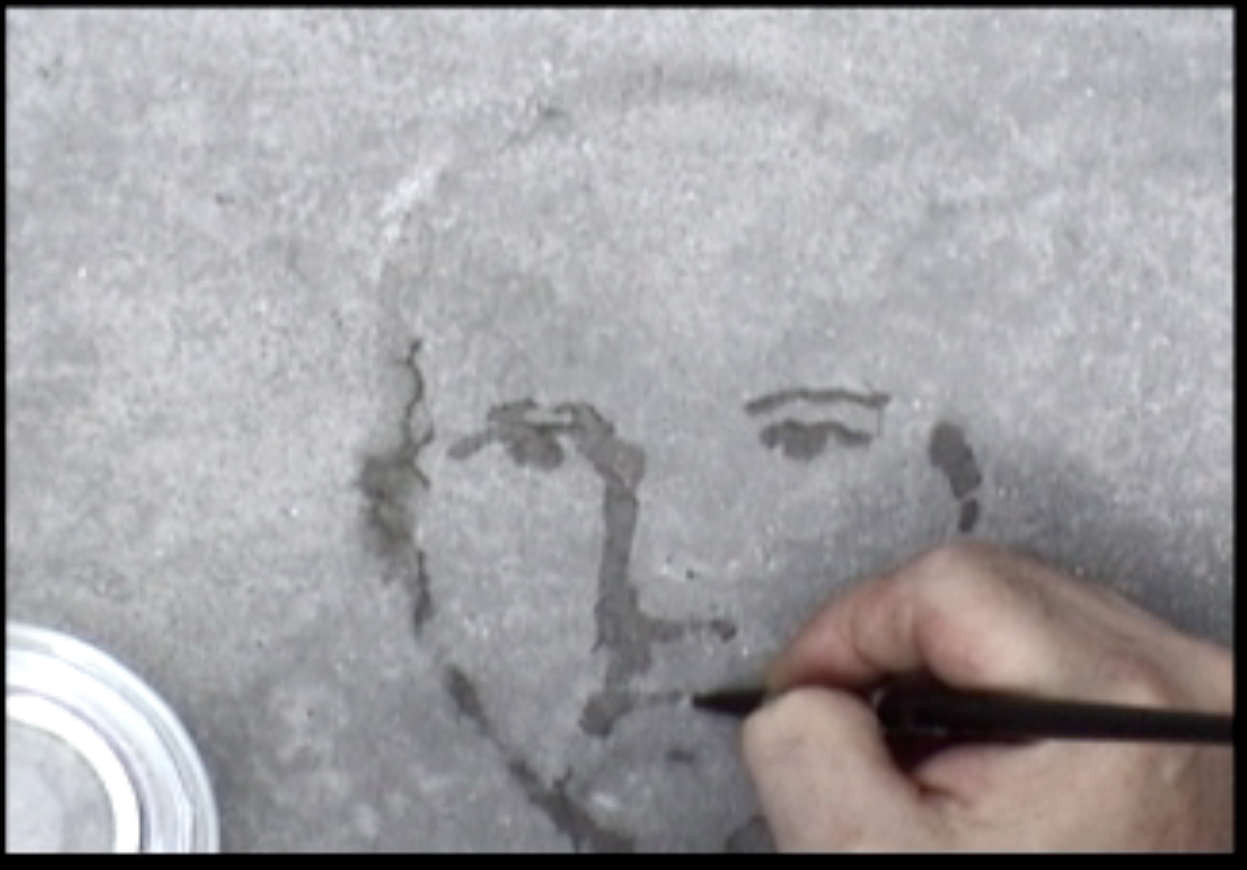 Oscar Muñoz. Re/Trato, 2004.
Still from video.
Oscar Muñoz. Re/Trato, 2004.
Still from video.

















